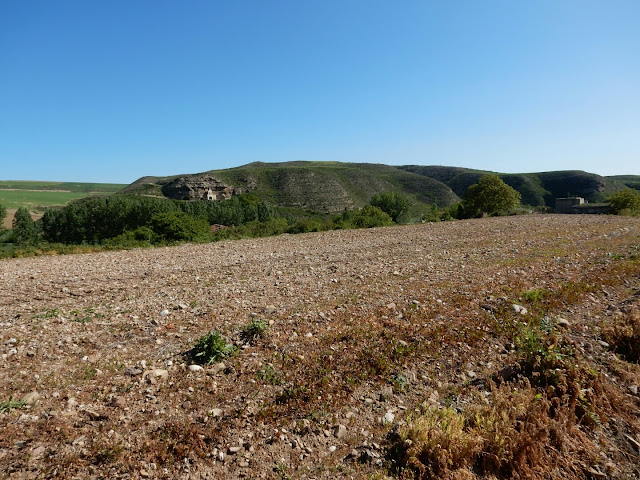 |
| Cave country! |
 |
| Rock shelters and a Hermitage. |
 |
| I check another stork nest for my tally - up to 32. |
 |
| Cliff-built church. |
 |
| Gothic churches mark every town. |
 |
So here are my thoughts for today:
All of the Americans I've met so far on this hike have been intelligent, aware of Spain's complicated history, and very excited to meet and be with people from all over the world. When we visit another country, even if we can't speak the language, we learn something valuable about each other's cultures, values, and hopes for the future. The lady I met today was, like the murder of a pilgrim last year, an anomaly. She carried all of her fears and biases heavily on her frame like an extra 60 pound pack. This weight is unnecessary and most painful. I prayed that she and her daughter might shed some of their ignorance and open their eyes and ears to this incredible experience.
The Camino pilgrim experience is meant to be highly personal -some like to say spiritual, others say religious. The top three questions when meeting someone new ( this can mean a dozen times a day) are:
What is your name?
Where are you from?
Why are you doing the Camino?
I haven't heard anyone say they are doing it to gain access to heaven, or to see relics of saints, or to do penance - though there is one young man walking with a social worker from Norway who was given the Camino as his alternate prison term. What I have heard a lot of is to find themselves again, as if they've become lost. I can relate.
The Camino is not easy. It is not a fixed trek from point A to point B everyday. You have to make decisions and prepare. Sometimes the way is brutally long. Sometimes you run out of water. The next town might be deserted when you thought you might find a place to eat or sleep. There are hard days of hiking steep ups and downs, long boring days of dust and sun, or mud and rain. There is no tour guide to take you to your hotel and seat you at the restaurant. You don't understand the menu and you find your stomach rebels at certain foods.
Spain is a country that can barely contain itself. There are the fiercely independent autonomous regions. There are four official languages. There are as many ways to say Hello, Good Day, as there are innumerable dialects and you will always pick the wrong one. But here's what the Camino teaches you, stumbling, shuffling, aching pilgrim: the Spanish people love you for trying, and happily answer with a smile as big as the sky "Buen Camino!" They invite you into their homes (casa rural) and offer their kitchens to cook a dinner. They don't care if you are German, Italian, Brazilian, Canadian, Danish, Irish, Scottish, or Hungarian. They really don't give a rat's behind if you think your country is the greatest or the most powerful. They want you to rest from your hard day, come sit and read, relax. Stay today and if you like, tomorrow. But don't wear out your welcome. Keep going.
The Camino is not about Santiago de Compostela at the end. It's a powerful stop along the way, yes. But it's about the continuation of this journey beyond the Cathedral and the Pilgrims Mass and the mighty, smoke- belching incense burner that flies high over your head. This is how God wants us to be - in and of the world, to love it now, here, the hard parts especially. The Camino is a metaphor for our journey here on Earth. A journey from hiding in caves from packs of wolves and running through gangs of thieves- to realizing, as I hope lady in her head net does, that we are all in this together. What better way to walk the path of life than in kindness and humility for all we are given every day.
















